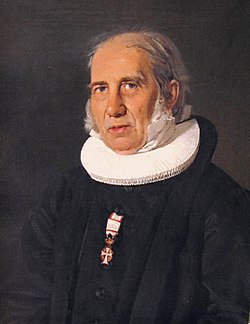Danebod
Danebod (pronounced "DAHN-a-bo", or "DAN-a-bo"[2]: 380 [3]) is a historic district at the south edge of the railway town[4] of Tyler in southwestern Minnesota.
Hans Jørgen Pedersen (1851–1905), the district comprises a group of buildings dating back to 1888 from Minnesota's oldest Danish immigrant settlement.
[9][10] Queen Thyra is recorded in medieval accounts to have directed the building of the Danevirke, a defensive earthwork across Jutland as protection against foes to the south.
Due to her importance and good policies, she was given the name Danebod, which can be variously translated as "one who mends, comforts, or saves the Danes".
This committee soon made arrangements with Winona and the St. Peter Railroad Company to purchase 35,000 acres (140 km2) of land in the southeastern part of Lincoln County, Minnesota.
The land was rolling prairie by the hills of Buffalo Ridge, just south of the community of Tyler, Minnesota.
The Grundtvigians represented a nationalistic and liberal religious tradition, in staunch contrast to pietists and fundamentalists in the Church Association for the Inner Mission in Denmark.
[11]: 9 On July 11, 1886, a meeting was held at the home of P. N. Clausen at which the Danebod congregation was formally organized with fifteen members.
Instead, the people met in various homes to sing Danish hymns and listen to a reading of the sermon by a layman.
Pedersen had a humble upbringing in Denmark, where he later studied at Ryslinge Folk High School before emigrating to America in 1875.
[12]: 13–14 One of the pastor's six children, Sigurd Pedersen, described their first arrival in Danebod in his autobiography: "It was a chilly morning, when the committee stood on the platform to bid welcome to the new pastor and his wife, trailed by six children, and the rear held up by the trusty hired man, Søren Olsen, who was to keep count of the straying flock and see that the last luggage was not forgotten.
Then the committee guided us to a small house on the corner just west of the present-day Chevrolet dealer, where businessman Carl Cold Sorensen brought the first automobiles to the area in the early 1900s.
The Stone Hall quickly became the center of the new colony, and Sunday services were conducted here, as well as numerous weddings, baptisms and funerals.
A Ladies' Aid society was established on July 15, 1903, with board members Marie Hovgaard, Anna P. C. Petersen, Henrietta Hansen, and Sine C. Jensen.
[12]: 24–52 In her travel diary entitled My Big Adventure of 1915–1916: The joys and hazards of motor touring in 1915, Danebod local Ragna C. Olson (1905–2007) described the average school day in 1914: "We had an hour of religion, then learned how to read and write Danish, some history, and the last hour we girls learned work such as knitting, crocheting and embroidery.
Speakers at the dedicatory exercises were Pastor Knudsen, C. P. Højbjerg, Aage Møller, P. Rasmussen, and Kristian Østergaard.
Meanwhile, a terrible epidemic of influenza swept the county, and all churches and schools were temporarily closed in an effort to halt the deadly disease; but many people died.
[26] During the 1930s, a combination of financial pressure and low enrollment forced the Danish-language based Danebod Folk School to close down.
Æbleskiver Days is one of the town's top attractions,[7] and has been held annually by Danish descendants for more than a hundred years.
[31] During this festival, there is a parade inspired by Danish traditions and culture that goes down Main Street with floats made by the various neighborhoods.
[36] Closest to Lake Danebod stands the Folk High School, a three-story wooden building with eight gables.







